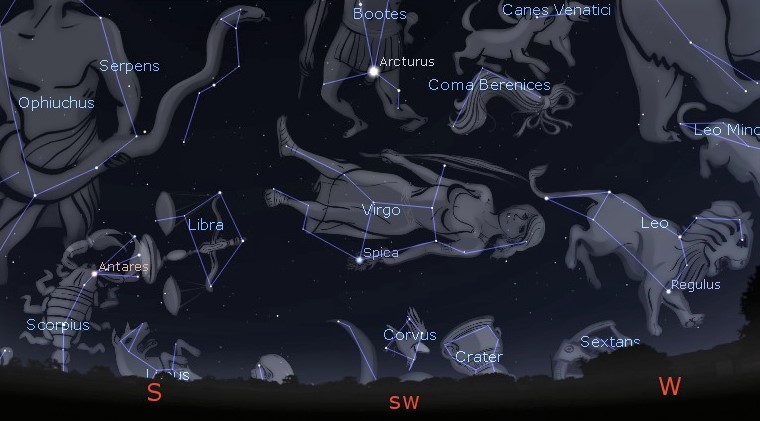This Week’s Sky at a Glance, 2023 June 17 – June 24

This Week’s Sky at a Glance, 2023 June 17 – June 24
Five millennia ago, Persian and perhaps Egyptian astrologers designated four of the first magnitude stars (the 20 brightest) as Watchers of the Sky, with each guarding one of the four cardinal directions. With their proximity to the Sun at the equinoxes and solstices they were also used to mark seasonal changes. Collectively, they were known as the Royal Stars.
Regulus in Leo and Antares in Scorpius were two of the Royal Stars, and we see them now appearing through evening twilight. Regulus guarded the north and marked the summer solstice, while Antares guarded the west and marked the beginning of autumn. Fomalhaut, in Piscis Austrinus below Aquarius, guarded the south and marked the winter solstice. Aldebaran, currently rising in Taurus an hour before sunrise, guarded the east and marked the spring equinox. These stars no longer mark the seasons as they did 5000 years ago due to precession of Earth’s polar axis, which makes one complete wobble every 25,800 years. On the summer solstice, the Sun is now located near the border of Gemini and Taurus.
None of the Royal Stars make the top ten in brightness. The brightest star in the sky for this time of year, Arcturus, is at its highest at sunset. It precedes almost equally bright Vega, which anchors the Summer Triangle with Deneb and Altair. Vega reaches its highest point about half an hour before Fomalhaut rises around 2:30 am. These two stars are the same distance from us, at 25 light years.
This Week in the Solar System
Saturday’s sunrise in Moncton is at 5:27 am and sunset will occur at 9:12 pm, giving 15 hours, 45 minutes of daylight (5:35 am and 9:14 pm in Saint John). Next Saturday the Sun will rise at 5:28 am and set at 9:14 pm, giving 15 hours, 46 minutes of daylight (5:37 am and 9:6 pm in Saint John). The summer solstice occurs on Wednesday, June 21, at 11:58 am.
The Moon is new early Sunday morning, providing an opportunity to see a 20-hour-old crescent that evening. It will make a scenic visit with Venus and Mars on Wednesday evening, with the Gemini Twins not far away. Saturn is stationary on Sunday, beginning four and a half months of retrograde motion relative to the stars. Jupiter rises around 3 am this weekend and stands about 20 degrees above the horizon two hours later. Mercury rises 45 minutes before sunrise and you will need a clear horizon to see it in binoculars before twilight gets too bright.
The first RASC NB star party of the year occurs this Friday and Saturday at Kouchibouguac National Park. See the rascnb.ca website for details. On Sunday evening at 8 pm, tune in to the Sunday Night Astronomy Show via the Facebook page or YouTube channel of Astronomy by the Bay.
